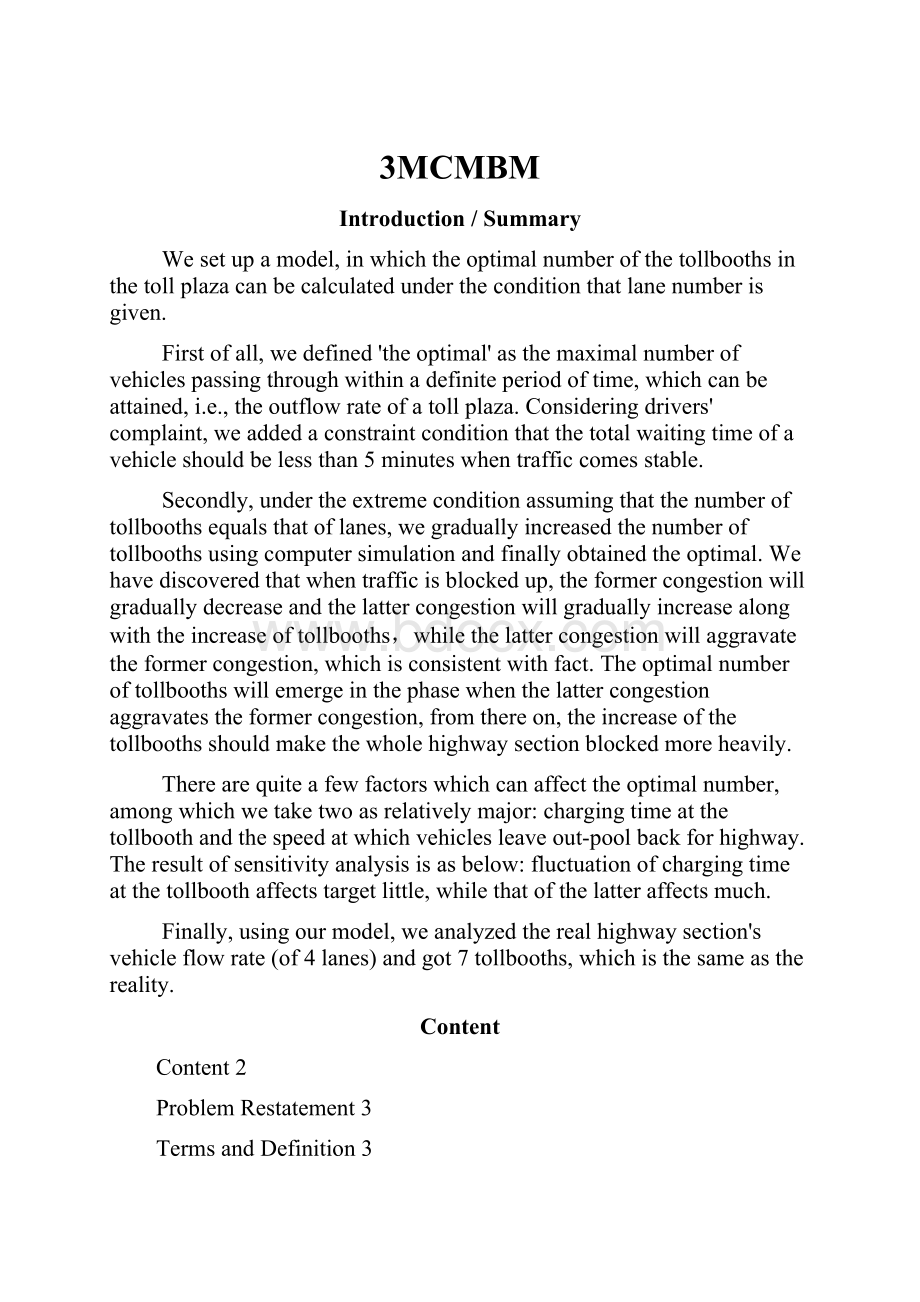3MCMBM.docx
《3MCMBM.docx》由会员分享,可在线阅读,更多相关《3MCMBM.docx(28页珍藏版)》请在冰豆网上搜索。

3MCMBM
Introduction/Summary
Wesetupamodel,inwhichtheoptimalnumberofthetollboothsinthetollplazacanbecalculatedundertheconditionthatlanenumberisgiven.
Firstofall,wedefined'theoptimal'asthemaximalnumberofvehiclespassingthroughwithinadefiniteperiodoftime,whichcanbeattained,i.e.,theoutflowrateofatollplaza.Consideringdrivers'complaint,weaddedaconstraintconditionthatthetotalwaitingtimeofavehicleshouldbelessthan5minuteswhentrafficcomesstable.
Secondly,undertheextremeconditionassumingthatthenumberoftollboothsequalsthatoflanes,wegraduallyincreasedthenumberoftollboothsusingcomputersimulationandfinallyobtainedtheoptimal.Wehavediscoveredthatwhentrafficisblockedup,theformercongestionwillgraduallydecreaseandthelattercongestionwillgraduallyincreasealongwiththeincreaseoftollbooths,whilethelattercongestionwillaggravatetheformercongestion,whichisconsistentwithfact.Theoptimalnumberoftollboothswillemergeinthephasewhenthelattercongestionaggravatestheformercongestion,fromthereon,theincreaseofthetollboothsshouldmakethewholehighwaysectionblockedmoreheavily.
Therearequiteafewfactorswhichcanaffecttheoptimalnumber,amongwhichwetaketwoasrelativelymajor:
chargingtimeatthetollboothandthespeedatwhichvehiclesleaveout-poolbackforhighway.Theresultofsensitivityanalysisisasbelow:
fluctuationofchargingtimeatthetollboothaffectstargetlittle,whilethatofthelatteraffectsmuch.
Finally,usingourmodel,weanalyzedtherealhighwaysection'svehicleflowrate(of4lanes)andgot7tollbooths,whichisthesameasthereality.
Content
Content2
ProblemRestatement3
TermsandDefinition3
Assumptions4
AboutInterstate-954
Abouttheweather4
Aboutthedriver4
Aboutthevehicles4
Aboutthetollbooths5
Aboutthein-pool&out-pool5
SomeFactsDerivedfromAssumptions5
AnalysisandModelDesign6
Overview6
Analysis6
Modeling7
ModelResultAnalysis10
SingleLaneCase11
Multilanecase13
Special(n-n)case14
Theanswertothequestionraisedintheproblem16
ModelVerification17
DataAcquisition17
Simulation19
ModelSensitivity20
SensitivityofminLeavingIntervalInSingleLane20
Sensitivityofservingtimeoftollbooths21
FurtherWork23
ModelStrengthandWeakness23
References24
TheOptimalNumberofTollbooths
ProblemRestatement
Somebusytollroadsaremulti-lanehighwayswithsometollplazasscatteredallover.Sincenooneiswillingtoexperiencecontinuoustrafficdisruption,itisdesirabletolimittheamountoftimespentontollplazas.
Commonlyatollplazaismadeoftollbooths,amuchlargernumberofwhichislocatedthantheenteringtravellanessoastofitwellintotheroaringtrafficinflow.Vehiclesfanouttotollboothstobeserved,andthentaketroubleinsqueezingoutofthebottleneckatthedepartureoftollplaza,finallygobacktoanormalnumberoflanes.Chancesarethatcongestionhappensinthebottleneckwhentrafficisheavy.Congestionattheentryoftollplazaisalsopossibleaslongastheinflowrateisoverwhelming,thoughthepossibilityisnotsohigh.
Makeamodeltodeterminetheoptimalnumberoftollboothsinabarrier-tollplaza,giventhefreedomtodefinewhattheword“optimal”meansinthecontextofpaper.Payspecialattentiontothesituationwherethenumberoftollboothsisthesameasthatoftravellanesandcomparethatsituationoneffectivenesswithcurrentpractice.
TermsandDefinition
Weassumethetollplazaas[Figure1]:
Figure1:
Thetopviewofatollplaza.
Alistofrelevantvariables,constants,andparametersisin[Table1].
Terms
Definitions
In-pool
Spaceforthevehiclestopassthetollbeforegoingtothetollbooths
Out-pool
Spaceforthevehiclestoleavethetollplazawhenpaidforthetoll
Inflow
Thetrafficflowintothein-pool
Outflow
Thetrafficflowintotheout-pool
Interval
Theword“Interval”canbeeitherseparationintimeorinspace.Herewejustuseitintimedelay,whiletheword“Distance”isusedforspace.
Distance
numOfLanes
ThenumberofLanesinthehighway.
numOfBooths
Thenumberoftollboothsintheplaza.
Theformercongestion
The50%filledstateinin-pool.
Thelattercongestion
The50%filledstateinout-pool.
numOfWaitingInFormer
Thenumberofvehicleswaitingintheformercongestion.
numOfWaitingInLatter
Thenumberofvehicleswaitinginthelattercongestion
minLeavingIntervalInSingleLane
Theminimalintervalbetweentwovehiclesgettingoutofthedepartureinonelane.
Thetotalwaitingtime
ThetotaltimeforonevehiclefromenteringIn-pooltogettingoutofOut-pool.
maxDriverTolerance
Themaximaltotalwaitingtimethatadrivercantolerate.
(n-m)deployment
[abbr.(n-m)]
AtollplazaconfigurationwithnumOfLanes=n&numOfBooths=m
Ci
Thetimeconstantusedintheformercongestion
Co
Thetimeconstantusedinthelattercongestion
α
Thesecondterm’scoefficientoftimedelayinout-pool
η
Thethirdterm’scoefficientoftimedelayinout-pool
U-Vdiagram
Adiagramwithx-axislabeledUandy-axislabeledV
Table1:
TermsandDefinitions
Assumptions
AboutInterstate-95
1.Accordingtoreference[1],theAADT(AnnualAverageDailyTraffic)ofInterstate-95inyear2001is60,414.
2.Accordingtoreference[1],Interstate-95has8lanesand4lanesineachdirection.
Abouttheweather
1.Weassumetheweatherisfineandhasnobadeffectoncharacteristicsofthevehicles.
Aboutthedriver
1.Usually,therangeofreactiontimeofthehumanbeingsisfrom200msto300ms.Weassumeitis250ms.
2.maxDriverTolerance=5min.
Aboutthevehicles
1.Itisassumedthatthearrivalofvehiclesisabitstochastic,butstationaryinthelonghurl.Asusual,wemodelthearrivaltimeofvehiclesasPoissondistributedrandomvariables,withtheintervalsfollowingtheprobabilitydensityfunction:
With1/λtheaveragetrafficflowrate.
2.Vehiclesarehomogeneous.
a)Allvehiclesareinthesamelengthof4.5m.
b)Thedistancebetweentwovehicleswaitingpayingforthetollisthe1.5m.
c)Empirically,ittakesavehicleabout25sec~30sec(27seconaverage)tospeedupfrom0km/hto80km/h.
d)Empirically,thevehiclehastoslide40muntilitcanbrakeataspeedof80km/h
e)Thedistancebetweentwovehiclesinthesamelanegettingoutofthedepartureofthetollplazaisatleast10msoastoavoidcollision.
Aboutthetollbooths
1.Allthetollboothsareindependent.Theyprovidetheserviceforthevehiclesindependently,thustheyhavenoideaofcorrelatingtheservicetimetoavoidthecongestionintheoutpollwhichastheempiricalparametershowsis60s.
Aboutthein-pool&out-pool
1.Empirically,thedistancebetweentheentryoftollplazaandeachtollboothis200m.Sodoeseachtollboothtothedeparture.(shownin[Figure1])
2.Thecapacityofthein-pool&out-poolisbasedontheirshapes.
3.Ci=16sec.
4.Co=20sec
5.η=5sec.
6.α=10sec.
SomeFactsDerivedfromAssumptions
1.Theaccelerationanddecelerationofavehiclecanbeevaluated:
(mentionedinAssumption:
vehicles.2.c))
(mentionedinAssumption:
vehicles.2.d))
2.minLeavingIntervalInSingleLanecanbeevaluated:
Interval=5sec(mentionedinAssumption:
vehicles.2.e)andaccelerationvalue)
Notes.Ifweassumeavehiclewon’tstarttoleaveuntilitsprecedentisonitswaywith10mdistance,thenaccordingtoaccelerationdata,wecanderive:
3.Thepoolsizeofbothin-poolandout-poolsatisfiesthefollowingfunction:
Note:
Wecanderivetheexpressionsfromincrementanalysis.
IfnumOfBoothsincreasebyone,thepoolwillincreaseby10slots.Ifdoingso,theareaofpoolwillgrowbyonetriangle,asshowninthefollowingfigure.
Howmanyvehiclesthetrianglecanhold?
Thetrianglehasaheightof200meterslongandabottom,abletoholdonevehicle(atollbooththere).Weassumeeachvehicleis4.5meterslongandsharesafreespaceof5.5meterswithitsneighbors.Bydivision,20vehiclesareabletopileinarectanglewithheightof200metersandwidthof1vehicle,whoseareaistwiceasmuchasthatoftriangle.Thussuchatrianglecanhold10vehicles,whichisjustthecoefficientassociatedwithnumOfBooths.
Ontheotherhand,ifnumOfLanesincreasebyone,theprocessofanalysisisalmostthesameexceptthatanothertollboothhastobeaddedsoastopreventcongestion.ThusthecoefficientassociatedwithnumOfLanesis20.
Figure2:
Illustrationonincrementanalysis
AnalysisandModelDesign
Overview
Ourgoalistosetupamodeltogettoknowthebehavioroftollplazaserving,andthentrytousethatmodeltoworkouttheoptimalnumberoftollbooths,withrespecttothenumberoflanesandthedefinitionof“optimal”weraised.
Analysis
Twoplacesarehotspotsofcongestion,theplacebeforethetollboothswheretherecouldbeaverylongline(“theformercongestion”)andtheplacebeforethedepartureoftollplaza(“thelattercongestion”).
Theformercongestionisrelatedtotheservingtimeoftollbooths,thesmallertheservingtimeis,thelessprobablewillthiscongestionhappen.Thelattercongestionisrelatedtotheleavingrateofthedepartureandthenumberofvehiclesstayinginthatposition.
Thesetwokindsofcongestionarenotuncorrelated.Oncethelattercongestionhappens,theformeronewillhappensoonerorlaterastheonlydrainofthetrafficflowisblocked.However,theformercongestionwillnothavesucheffects.
Wecanimagethattheformercongestionwillhappenifthearrivalofthevehicleshasexceededthecapacityofthetoll